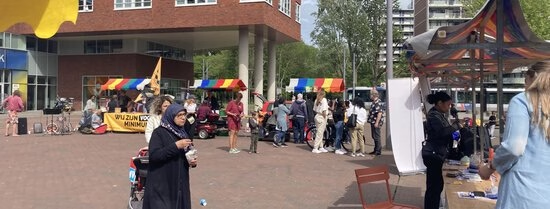In the past few months, researcher Seline Westerhof looked into the world of residents' initiatives and community organizations on Rotterdam-Zuid, as part of the SPRING project of the Resilient Delta Initiative. In what ways do these initiatives and organizations come to life? How are different institutions involved? And where exactly are they located? In this interview, Seline explains how she researched this and what her main findings are.
What exactly did you want to study and what is the importance of your research?
In mapping the initiatives and organizations in Rotterdam-South, I started by asking where in Rotterdam-South the initiatives and organizations are located and how they are structured. This allowed me to find out which topics, people and neighbourhoods are mainly in the spotlight, and which are not (yet). This creates a nice basis for follow-up research by SPRING, which will provide insight into which social networks are present in the various neighborhoods. Researchers will then know better what to look for and in which areas they can best approach people.
How did you conduct this research?
In the beginning, I searched via Google, in Facebook groups and local platforms what kind of initiatives could be found in Rotterdam-South. I also emailed a number of people to ask if they knew any initiatives in their neighbourhood. During this first phase of mapping initiatives, I already noticed differences between the four districts in South. To better understand which locations were involved, besides searching online, I also cycled around in different areas. That way I could experience what it was like to be there, among the buildings, parks, and people.
In the second part of the research, I had conversations with a board member of a playground and with volunteers and welfare workers from Houses of the Neighbourhood (community centers) in the different districts. A few times I was shown around in a neighbourhood, where many people shared their experiences with me.
The study shows that there are large differences in the number of residents' initiatives within the different neighbourhoods in Rotterdam-South. How can this be explained?
According to several studies, neighbourhoods in Feijenoord and Charlois have high levels of poverty, crime and more people live there with only a secondary school diploma compared to other parts of Rotterdam. For these reasons (among others), a lot of attention is being paid to improving the livability and safety in these neighbourhoods. Researchers and policymakers do this with good intentions, but it also has adverse consequences. What happens is, that in IJsselmonde and Hoogvliet, there is less attention for welfare issues and setting up or supporting initiatives and social organisations, while there is a need for this. The geographical location of the districts with regard to the center of Rotterdam also influences this. Consequently, the northern side of Rotterdam-South (Feijenoord and Charlois) is overrun with attention, and the southern side (IJsselmonde and Hoogvliet), which is further away from the center, is lost sight of.
What can the municipality and other parties do with your insights? And what do you think is important in follow-up research on residents' initiatives in Rotterdam South?
It is important to consider how and who you approach for research. You need to have a different kind of conversation with people who already get a lot of attention and at the same time feel they are not really being heard. Thus, pay attention to what you promise them and invest in a good relationship. Ask yourself, where are the places, who are the people, what do they have to say? Go out into the neighbourhoods, walk or cycle around the areas you write about. During research it is also important to seriously consider small conversations or observations at a location that are not directly part of the chosen research method. They can tell a lot about a place and the people who are there and can be a cue for further investigation.
Look at what happens in, for example, community centers, playground associations, and some local shops. While activities in these places are not always precisely formalized or communicated, they are important and mostly, accessible, meeting places for people.
The divide in Rotterdam-South
- More information
Vital Cities and Citizens
With the Erasmus Initiative Vital Cities and Citizens (VCC) Erasmus University Rotterdam wants to help improve the quality of life in cities. In vital cities, the population can achieve their life goals through education, useful work and participation in public life. The vital city is a platform for creativity and diversity, a safe meeting place for different social groups. The researchers involved focus on one of the four sub-themes:
- Inclusive Cities and Diversity
- Resilient Cities and People
- Smart Cities and Communities
- Sustainable and Just Cities
VCC is a collaboration between Erasmus School of Social and Behavioural Sciences (ESSB), Erasmus School of History, Culture and Communication (ESHCC) and International Institute of Social Studies (ISS).

